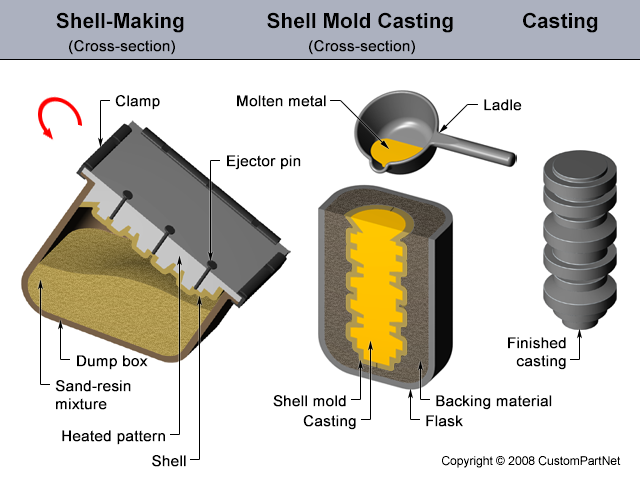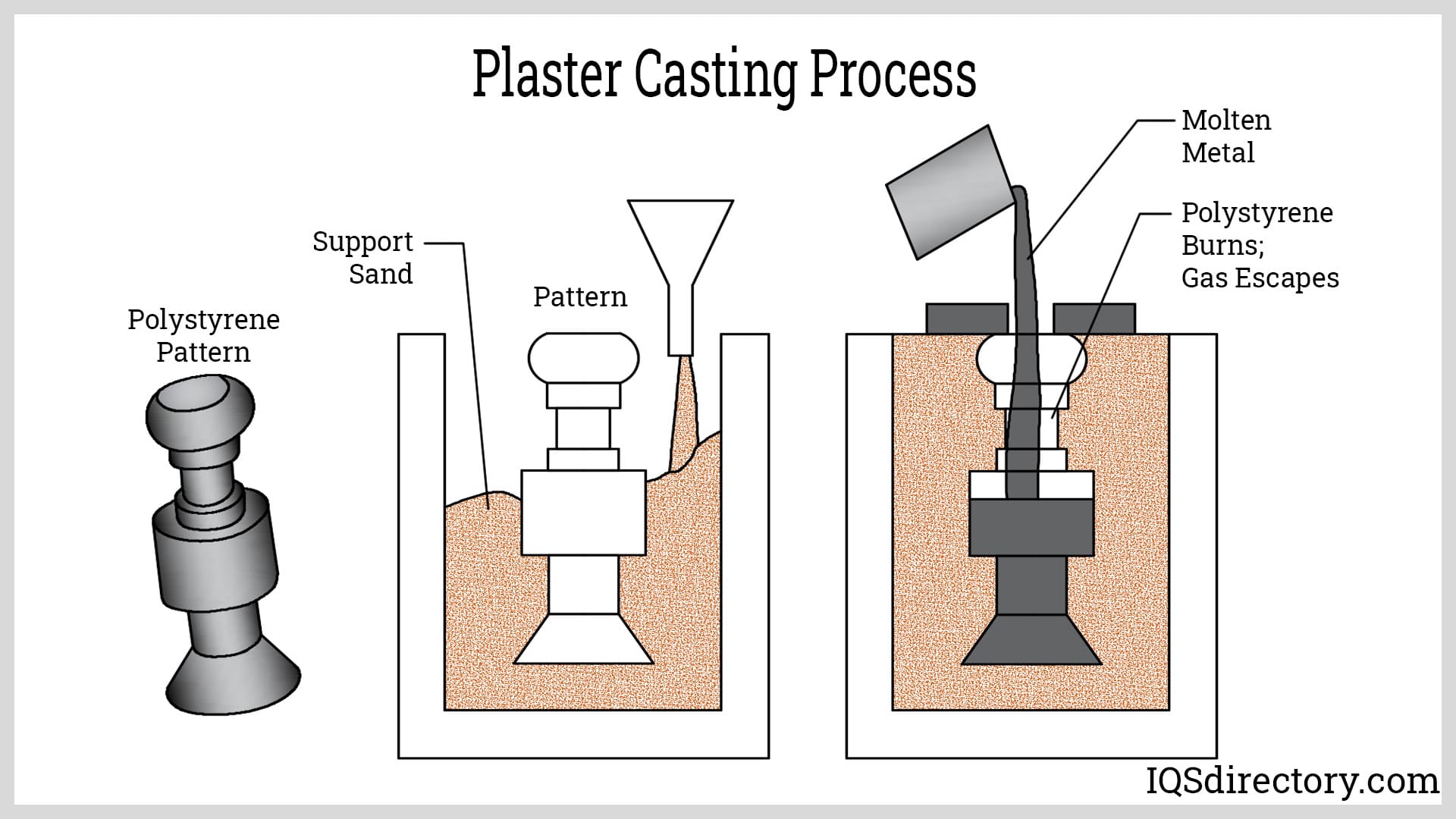Metal Castings and their lasting importance in today’s global industries
Wiki Article
Comprehending the Metal Castings Process: A Comprehensive Overview for Beginners
The Metal Casting procedure is a basic strategy in producing that transforms molten metal right into solid forms. Newbies have to grasp the numerous approaches included, such as sand casting and pass away casting. Understanding the products, style principles, and safety and security procedures is similarly essential. Each facet plays a crucial role in accomplishing successful end results. As one navigates these intricacies, the inquiry of exactly how to optimize each action for improved results comes to be progressively important.The Basics of Steel Casting
Although Metal Casting has actually evolved over centuries, its basic principles continue to be indispensable and consistent to the production process. At its core, Metal Casting entails the makeover of liquified steel into solid objects with different techniques. The process starts with the development of a mold and mildew, which defines the shape of the end product. Once the mold is prepared, steel is warmed to its melting point and poured into the dental caries. After cooling down, the metal solidifies, taking the shape of the mold and mildew.There are numerous casting methods, including sand casting, financial investment casting, and die casting, each with one-of-a-kind advantages and applications. The choice of method relies on elements such as production quantity, product type, and desired precision. As soon as cast, the end product might undertake additional processes like machining or surface treatment to attain the required finish and specs. Recognizing these essentials is essential for any individual interested in the field of Metal Casting.

Understanding Products Utilized in Metal Casting
Products play a vital duty in the Metal Casting process, affecting the final product's residential or commercial properties and performance. Different metals are used, including light weight aluminum, steel, iron, and bronze, each offering unique characteristics fit for specific applications. Aluminum is corrosion-resistant and lightweight, making it perfect for auto parts. Iron, particularly cast iron, is preferred for its exceptional wear resistance and sturdiness. Steel offers high strength and flexibility, frequently used in hefty machinery components. Bronze, known for its rust resistance and machinability, is frequently employed in marine applications.In addition to the steels, various casting products, such as sand, plaster, and ceramic, are used to create mold and mildews. Sand spreading, the most widespread technique, utilizes silica sand due to its thermal stability and capability to develop elaborate forms. Plaster and ceramic molds use better information yet might need more complex procedures. The selection of materials directly affects the efficiency, expense, and quality of the spreading procedure.
The Layout Process: From Concept to Plan
The layout procedure in Metal Casting starts with the initial idea advancement, where ideas are produced and assessed. This is adhered to by the application of CAD modeling techniques, permitting precise visualizations of the layout. Finally, the blueprint finalization actions guarantee that all specifications are precisely documented for production.Preliminary Concept Development
First principle advancement marks a vital stage in the Metal Casting process, where concepts change into tangible layouts. During this phase, developers team up with stakeholders and engineers to brainstorm and refine first ideas. They think about factors such as capability, aesthetic appeals, and manufacturability, guaranteeing that the design fulfills the needed specifications and efficiency requirements. Illustrations and outlines are created to envision the ideas, enabling for initial evaluations of feasibility and cost-effectiveness. This phase likewise involves identifying products and potential spreading methods that align with the layout objectives. Ultimately, preliminary concept development lays the foundation for a complete blueprint, leading the succeeding phases of the casting procedure and guaranteeing an effective change from idea to fact.CAD Modeling Techniques
Transforming principles into precise layouts, CAD modeling methods play a pivotal duty in the Metal Casting process. These methods utilize innovative software application to develop in-depth three-dimensional models that accurately show the designated item. By using tools such as parametric modeling, solid modeling, and surface area modeling, designers can control dimensions and forms easily. CAD systems additionally facilitate simulation and analysis, enabling the recognition of possible defects before manufacturing starts. This aggressive approach decreases material waste and enhances the layout for manufacturability. In addition, CAD versions can be easily modified, allowing quick versions based upon comments. Basically, CAD modeling acts as the backbone of the design procedure, linking the gap between preliminary principles and the eventual production-ready designs.Plan Completion Tips
Adhering to the development of in-depth CAD versions, the following stage entails plan completion, which is crucial in equating digital styles into actionable prepare for production. This process begins with reviewing the CAD models for accuracy and conformity with requirements. As soon as validated, the measurements, resistances, and material specifications are meticulously detailed to assure quality. Integrating comments and notes assists interact important information regarding spreading procedures, surface area coatings, and assembly needs. The wrapped up blueprint undertakes a strenuous authorization process, often involving collaboration with designers and manufacturing groups to address any kind of possible problems. Besides modifications are made and authorizations gotten, the plan is officially launched, functioning as the fundamental file for the succeeding phases of Metal Casting, including pattern production and mold style.The Metal Casting Methods Discussed

Metal Casting techniques encompass a variety of techniques utilized to shape molten metal into preferred kinds. These strategies vary according to the sort of material, complexity of the style, and manufacturing quantity. Sand spreading is among one of the most usual approaches, involving the development of a mold and mildew from sand to hold the liquified steel. Financial investment spreading, or lost-wax spreading, enables detailed designs by using a wax pattern that is melted away. Pass away casting uses high-pressure shot of molten metal into a mold, suitable for mass manufacturing. Various other methods consist of irreversible mold spreading, which uses recyclable mold and mildews, and centrifugal spreading, where rotational pressures aid in loading the mold and mildew. Each method has its applications and benefits, making it vital for producers to select the ideal technique based on their certain requirements and requirements. Recognizing these methods is necessary for anybody associated with the Metal Casting procedure.
Finishing Procedures: Enhancing Your Casted Product

Completing procedures play a crucial duty in enhancing the quality and appearance of casted products. Various surface treatment methods, such as sprucing up and layer, are employed to improve sturdiness and appearances. Additionally, top quality inspection approaches assure that the end product meets specified standards and efficiency needs.
Surface Area Therapy Methods
A range of surface treatment strategies play an essential role in enhancing the top quality and long life of casted items. These methods include methods such as shot blasting, polishing, and covering. Shot blasting effectively removes surface area flaws, enhancing the aesthetic and practical characteristics of the spreading. Sprucing up provides a smooth coating, which is specifically crucial for ornamental applications and elements requiring marginal rubbing. Finishing techniques, such as electroplating or powder covering, offer extra protection versus corrosion and wear, making certain resilience. Moreover, surface area therapies can boost attachment for succeeding processes, such as painting or bonding. By utilizing these techniques, makers can accomplish exceptional surface top quality, which is essential for the performance and life-span of Metal Casting in numerous applications.Top Quality Examination Approaches
Reliable quality evaluation approaches are crucial for assuring the stability and efficiency of casted products after the ending up procedures. Different strategies are employed to analyze the quality of Metal Casting, including aesthetic inspection, dimensional checks, and non-destructive screening (NDT) Aesthetic assessment permits for the identification of surface area issues, while dimensional checks guarantee that products meet specified tolerances. NDT methods, such as ultrasonic testing and radiographic evaluation, offer deeper understandings right into inner stability without damaging the spreadings. In addition, mechanical screening, such as tensile and solidity tests, reviews product residential properties - Metal Castings. By employing a combination of these approaches, makers can improve product high quality and dependability, inevitably causing higher client contentment and reduced manufacturing costsSecurity Considerations in Metal Casting
While the Metal Casting process uses many benefits, it also provides a variety of safety risks that should be meticulously handled. Workers in Wisconsin Aluminum Foundry casting facilities are exposed to heats, liquified metals, and dangerous products, which can result in severe injuries if correct preventative measures are not taken. Personal safety equipment (PPE) such as heat-resistant gloves, deal with guards, and safety clothes is vital to minimize risks.Additionally, the visibility of fumes and dirt necessitates correct air flow systems to ensure air high quality - Metal Castings. Regular training on safety and security procedures is important for all staff members to identify potential threats and respond effectively. Emergency situation treatments should be developed, including fire safety and security procedures and emergency treatment schedule. Upkeep of equipment and appropriate handling of materials additionally add to a much safer working environment. By focusing on these safety considerations, Metal Casting procedures can shield their workforce and maintain effective manufacturing processes
Regularly Asked Concerns
What Are the Ecological Effects of Metal Casting?
Metal Casting can lead to ecological influences such as air and water pollution, resource deficiency, and power consumption. Furthermore, inappropriate waste monitoring and exhausts from factories add to ecological disturbances and health and wellness threats for close-by communities.Just how Do I Choose the Right Metal for Spreading?
To choose the ideal steel for casting, one need to consider elements such as mechanical homes, deterioration resistance, thermal conductivity, and cost. Examining the desired application and environmental conditions is necessary for ideal selection.What Are the Typical Flaws in Metal Casting?
Usual defects in Metal Casting consist of porosity, contraction, sand addition, and misruns. These problems typically occur from improper material option, inadequate design, or imperfections in the spreading procedure, influencing the last item's top quality and efficiency.
Just How Can I Boost My Steel Casting Abilities?
To boost Metal Casting skills, one need to exercise regularly, research casting techniques, assess previous tasks for flaws, seek feedback from seasoned casters, and continuously try out various products and approaches to boost effectiveness and understanding.What Is the Cost of Starting a Metal Spreading Service?
Beginning a steel spreading service generally requires a first financial investment of $5,000 to $50,000, depending upon tools, products, and center costs. Elements like location and range can significantly affect overall start-up expenditures.The Metal Casting process is a fundamental strategy in making that changes molten steel into strong types. Novices have to understand the numerous approaches involved, such as sand spreading and pass away spreading. There are numerous casting approaches, consisting of sand spreading, financial investment spreading, and pass away casting, each with one-of-a-kind benefits and applications. Investment casting, or lost-wax casting, permits for complex designs by making use of a wax pattern that is thawed away. Various other methods consist of permanent mold spreading, which utilizes multiple-use mold and mildews, and centrifugal spreading, where rotational forces assist in loading the mold and mildew.
Report this wiki page